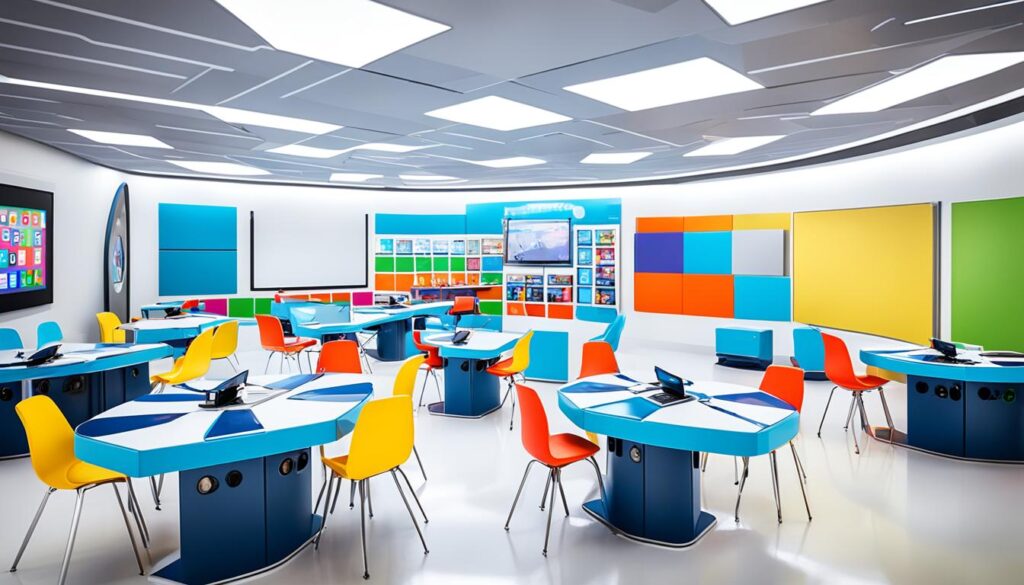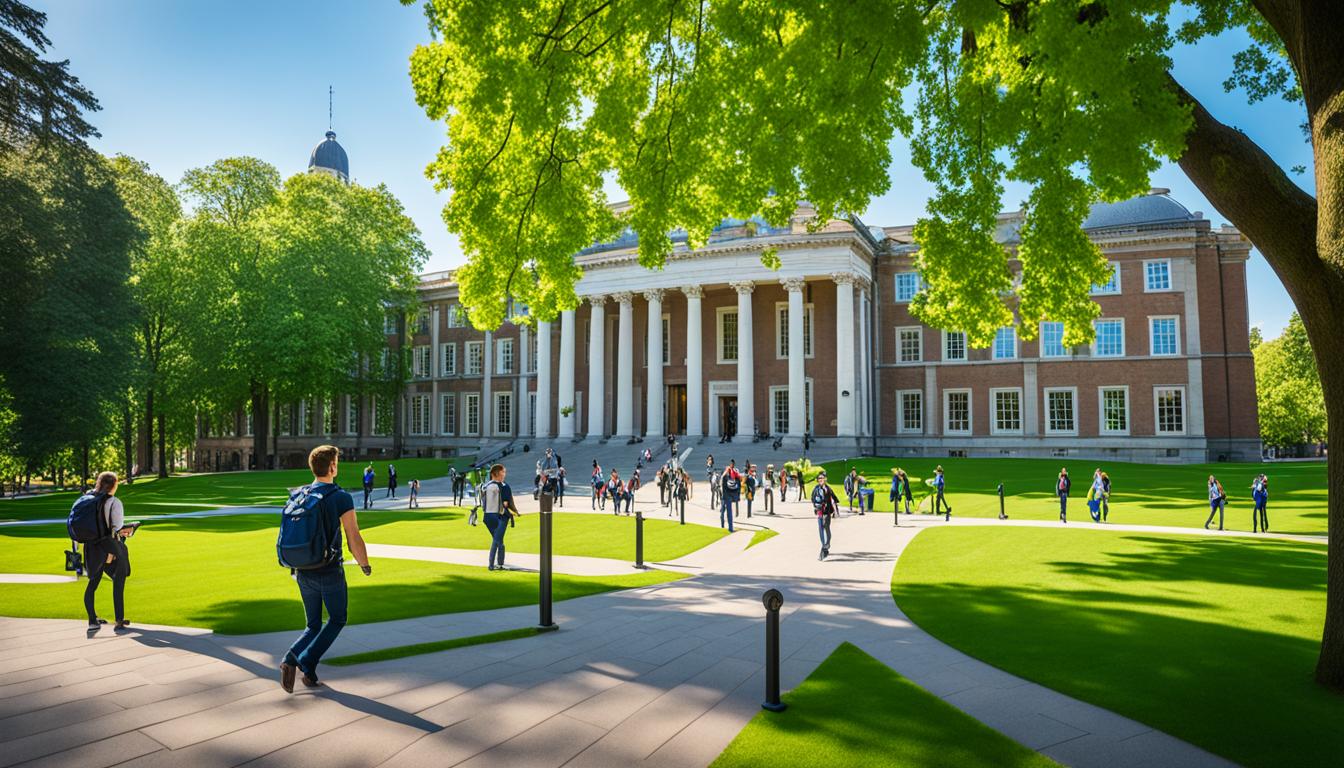In today’s fiercely competitive landscape of higher education, many institutions aspire to achieve top-tier status. This coveted position is reserved for leading educational institutes that excel in various facets of academic excellence. To guide educational institutions towards this prestigious goal, this article provides a comprehensive roadmap comprising essential steps and strategies.
At the core of achieving top-tier status lies the pursuit of higher education excellence. This encompasses academic distinction, internationalization, the tenets of a world-class university, high-quality institutions, innovative curriculum, superior learning outcomes, academic infrastructure, research classifications, strategic leadership, and stakeholder engagement. By implementing the roadmap outlined in this article, educational institutions can elevate their reputation, attract top talent, and contribute to long-term academic excellence.
Key Takeaways:
- Higher education excellence is a multi-faceted pursuit that encompasses various areas of distinction.
- Top-tier status requires a focus on academic distinction, internationalization, and stakeholder engagement.
- Institutions should prioritize curriculum innovation, research excellence, and superior learning outcomes.
- Investing in academic infrastructure and fostering strategic leadership are crucial steps towards achieving top-tier status.
- Continuous improvement and stakeholder engagement are essential for sustaining long-term academic excellence.
Embracing the Quest for Academic Distinction
In the pursuit of top-tier status in higher education, academic distinction plays a crucial role. Setting high standards, fostering a culture of excellence, and recognizing exceptional academic achievements are key components of this quest. By embracing the drive for academic distinction, educational institutions can differentiate themselves and attract top students and faculty members who are dedicated to pursuing excellence in education and research.
Academic distinction goes beyond mere grades or test scores. It encompasses a comprehensive approach to superior education that encompasses both academic achievements and the cultivation of critical skills. By creating an environment that values and rewards academic excellence, institutions can create a vibrant learning community where students and faculty are inspired to reach their full potential.
“Academic distinction is not just about being the best. It’s about nurturing the best in others and inspiring a passion for lifelong learning.”
Embracing the quest for academic distinction goes hand in hand with creating a supportive and enriching educational experience. It involves challenging students to think critically, encouraging them to pursue innovative research projects, and providing opportunities for intellectual growth.
When educational institutions prioritize academic distinction, they not only attract top students but also foster a community of scholars who thrive on intellectual stimulation and collaboration. The pursuit of academic excellence becomes ingrained in the institution’s DNA, creating an environment that fosters creativity, innovation, and scholarly achievement.
By embracing the quest for academic distinction, educational institutions can position themselves as leaders in providing a superior education. They become beacons of excellence that attract talented students and renowned faculty members, elevating their status in the competitive landscape of higher education.
In the following sections, we will explore other crucial aspects that contribute to achieving top-tier status in higher education, including the importance of university internationalization, the tenets of a world-class university, the value of high-quality institutions beyond academic rankings, the necessity of an innovative curriculum, the pursuit of superior learning outcomes, the enhancement of academic infrastructure and learning environments, the need to move beyond traditional research classifications, and the role of strategic leadership in higher education.
Understanding the Essence of University Internationalization
In today’s interconnected world, university internationalization plays a pivotal role in shaping the landscape of higher education. It encompasses various initiatives aimed at cultivating a global perspective, fostering international collaborations, and promoting cultural integration within academia. By embracing internationalization, educational institutions can create a vibrant and inclusive learning environment that prepares students to thrive in a diverse and interconnected society.
At the heart of university internationalization is the integration of a global perspective in curriculum development. By incorporating diverse perspectives, experiences, and knowledge from around the world, institutions can provide students with a comprehensive understanding of global issues and challenges. This equips graduates with the necessary skills and competencies to navigate an increasingly globalized workforce.

Fostering international collaborations and exchanges is another essential aspect of university internationalization. Through partnerships with other institutions and organizations worldwide, students and faculty are exposed to different cultures, ideas, and research methodologies. These collaborations not only enhance the quality of education and research but also promote cross-cultural understanding and the generation of new knowledge that transcends geographical boundaries.
However, cultural integration within academia presents both challenges and opportunities. Embracing diversity and inclusivity requires a deliberate effort to create an environment where individuals from different backgrounds feel valued and respected. It involves breaking down cultural barriers, addressing biases, and promoting intercultural dialogue. By doing so, educational institutions can foster a sense of belonging and create opportunities for cultural exchange and mutual learning.
In conclusion, university internationalization is essential in today’s globalized world. It allows educational institutions to equip students with a broad understanding of global issues, foster international collaborations, and promote cultural integration within academia. By embracing internationalization, institutions can cultivate a diverse and inclusive learning environment that prepares students to thrive in a rapidly evolving global society.
The Tenets of a World-Class University
In order to achieve top-tier status in higher education, it is crucial for institutions to embody the key tenets of a world-class university. Cultivating a distinguished faculty and student body, along with research excellence and its global impact, play integral roles in establishing and maintaining a reputation of excellence.
Cultivating a Distinguished Faculty and Student Body
Attracting and retaining a distinguished faculty is essential for a world-class university. These esteemed educators bring a wealth of knowledge, research expertise, and real-world experience to the institution, enriching the learning environment and fostering intellectual growth. A diverse and talented student body also contributes to the vibrancy of a world-class university, creating a dynamic community of learners who challenge and inspire one another.
Research Excellence and Its Global Impact
Research excellence is a hallmark of a world-class university and has a profound global impact. Through groundbreaking discoveries, innovative solutions, and impactful contributions to various fields, research conducted at these institutions drives societal progress and influences policies and practices worldwide. By fostering a culture of research excellence, institutions can attract top researchers, secure funding, and establish themselves as leaders in their respective academic disciplines.
Research conducted at world-class universities has far-reaching implications, addressing global challenges, improving lives, and shaping the future of various industries. Whether it’s groundbreaking medical advancements, technological innovation, or societal transformations, the global impact of research conducted at these institutions reverberates across borders and contributes to the betterment of humankind.
High-Quality Institutions: Beyond Academic Rankings
In the pursuit of educational excellence, high-quality institutions play a crucial role. While academic rankings provide valuable insights, they alone cannot fully capture the essence of a truly exceptional educational institution. To truly understand the quality of an institution, we must look beyond rankings and explore the factors that contribute to its excellence.
Strong leadership is a fundamental element of a high-quality institution. Visionary leaders set the tone and direction for the entire organization, fostering a culture of continuous improvement and innovation. They prioritize the overall well-being of students and create an environment that supports their growth and success.
At the core of a high-quality institution is a commitment to student success. This goes beyond just academic achievement and includes holistic support for students’ personal and professional development. From mentorship programs to career guidance, these institutions ensure that students are equipped with the skills and knowledge needed to thrive in the real world.
A supportive learning environment is another crucial aspect of a high-quality institution. This involves creating an inclusive and engaging atmosphere where students feel valued and supported. It encompasses factors such as access to resources, state-of-the-art facilities, and a vibrant campus community that encourages collaboration and diverse perspectives.
When evaluating the quality of an institution, it is essential to consider the breadth and depth of the educational experience. A well-rounded curriculum that combines academic rigor with opportunities for experiential learning and extracurricular activities is indicative of a high-quality institution. This ensures that students not only gain knowledge but also develop critical thinking, problem-solving, and communication skills that are essential for their future success.
As aspiring students, it is crucial to look beyond academic rankings and consider the overall quality of an institution. By focusing on elements such as strong leadership, a commitment to student success, a supportive learning environment, and a well-rounded educational experience, we can identify institutions that truly embody educational excellence.
Remember, it’s not just about the numbers and rankings. It’s about finding an institution that will provide you with the knowledge, skills, and support you need to thrive in your academic and professional journey.
Adopting an Innovative Curriculum for Future-Readiness
In today’s rapidly evolving world, educational institutions must adapt their curricula to prepare students for the challenges of the future. By adopting an innovative curriculum, schools can ensure that graduates are equipped with the necessary skills and knowledge to thrive in an increasingly complex and technologically advanced society.
Critical thinking and problem-solving skills are essential competencies for success in the 21st century. An innovative curriculum should prioritize the development of these skills, fostering students’ ability to analyze, evaluate, and creatively solve problems. It should encourage students to think critically, ask questions, and approach challenges from multiple perspectives.
Furthermore, an innovative curriculum should incorporate technological advances in education. This includes leveraging digital tools, interactive learning platforms, and emerging technologies to enhance the learning experience. By integrating technology into the curriculum, educational institutions can create engaging and dynamic learning environments that prepare students for the digital age.

By embracing an innovative curriculum that develops critical thinking, problem-solving skills, and incorporates technological advances, educational institutions can ensure that their graduates are future-ready. This approach prepares students to adapt to the evolving demands of the workforce and equips them with the skills needed to navigate a rapidly changing world.
Higher Education Excellence: Pursuing Superior Learning Outcomes
In higher education, the pursuit of superior learning outcomes is paramount. Educational institutions strive to provide students with a transformative and enriching academic experience that equips them with the knowledge, skills, and competencies needed for success in the modern world.
One of the key strategies to enhance student success is through personalized learning approaches. By tailoring the educational experience to meet the unique needs and interests of each student, institutions can foster a deep engagement with the material, promote critical thinking, and empower learners to take ownership of their education.
Furthermore, student support services play a crucial role in facilitating superior learning outcomes. By providing comprehensive resources such as academic advising, tutoring, career counseling, and mental health support, institutions can create a supportive and nurturing environment that enables students to excel academically and personally.
Experiential learning opportunities also contribute to superior learning outcomes by bridging the gap between theory and practice. Through internships, research projects, service-learning, and study abroad programs, students can apply their knowledge in real-world settings, develop practical skills, and gain a global perspective that enhances their overall educational experience.
“Education is the most powerful weapon which you can use to change the world.” – Nelson Mandela
By prioritizing higher education excellence and continually striving for superior learning outcomes, educational institutions empower their students to become lifelong learners, critical thinkers, and active contributors to society. Through personalized approaches, comprehensive support services, and experiential learning opportunities, institutions lay the foundation for student success and create a brighter future for individuals and communities alike.
Enhancing Academic Infrastructure and Learning Environments
In order to achieve top-tier status in higher education, it is crucial to prioritize the enhancement of academic infrastructure and learning environments. By investing in state-of-the-art facilities and equipment, educational institutions can provide students and faculty with the necessary resources and tools to thrive in their academic pursuits.
Investing in State-of-the-Art Facilities and Equipment
State-of-the-art facilities and equipment play a vital role in creating a conducive learning and research environment. By adopting cutting-edge technologies and modern equipment, institutions can offer students hands-on experiences and access to the latest advancements in their respective fields. This not only enhances the quality of education but also prepares students for the demands of the ever-evolving professional landscape.

Optimizing Support Services for Student and Faculty Success
In addition to upgrading physical infrastructure, optimizing support services is equally important in promoting student and faculty success. By providing comprehensive support services, such as academic advising, career counseling, and mental health resources, institutions can create a supportive and inclusive learning environment. These support services enable students and faculty to maximize their potential, overcome challenges, and excel in their academic and professional endeavors.
In conclusion, enhancing academic infrastructure and learning environments is a crucial step towards achieving top-tier status in higher education. By investing in state-of-the-art facilities and equipment, as well as optimizing support services, institutions can create an environment that fosters innovation, collaboration, and academic excellence.
Moving Beyond R1 Research Classifications
This section explores the need to go beyond traditional R1 research classifications and consider alternative approaches to evaluating research excellence. While R1 classifications have long been utilized as a benchmark for research quality, it is essential to examine additional factors that contribute to the overall research landscape.
Simplifying the Research and Development Expenditure Criteria
One aspect that needs reconsideration is the complex criteria associated with research and development expenditure. By simplifying these criteria, educational institutions can ensure a clearer and more accurate assessment of research investment and its impact.
Embracing Diverse Research Contributions Across Disciplines
Research excellence should not be constrained by disciplinary boundaries. Embracing diverse research contributions across various disciplines fosters innovation, collaboration, and a holistic approach to knowledge creation. In acknowledging and valuing the unique insights that different fields offer, educational institutions can drive interdisciplinary research and address complex societal challenges.
To illustrate the importance of diverse research contributions, consider the following table:
| Discipline | Diverse Research Contributions |
|---|---|
| Science | Investigating new materials for renewable energy |
| Humanities | Evaluating the impact of literature on social perceptions |
| Engineering | Developing sustainable infrastructure solutions |
| Social Sciences | Studying the effects of socioeconomic policies on inequality |
By acknowledging the diverse research contributions from various disciplines, educational institutions can foster a vibrant research ecosystem that encompasses a broad range of perspectives and methodologies.
Strategic Leadership and Vision in Higher Education
In order to achieve top-tier status in higher education, strategic leadership and vision play a pivotal role. Guiding educational institutions towards excellence requires visionary leadership, strategic planning, and effective governance. Leaders must provide clear direction and align organizational goals with the evolving landscape of higher education.
Strategic leadership involves setting a compelling vision for the institution and inspiring all stakeholders to work towards its realization. A visionary leader is able to anticipate future trends and challenges, and proactively adapt strategies to ensure long-term success. By communicating a compelling vision, leaders inspire faculty, staff, and students to strive for excellence and contribute to the institution’s growth.
Strategic planning is another key aspect of effective leadership in higher education. It involves the systematic process of defining goals, identifying strategies, allocating resources, and monitoring progress. By engaging in strategic planning, institutions can align their efforts, prioritize initiatives, and make informed decisions that support their long-term vision. Strategic planning also enables institutions to anticipate and respond to changes in the higher education landscape, ensuring their continued relevance and competitiveness.
Effective governance is crucial for driving institutional success. It encompasses the structures, processes, and systems through which decisions are made and implemented. Strong governance ensures transparency, accountability, and the efficient utilization of resources. It also fosters a culture of collaboration and shared responsibility, enabling stakeholders to work together towards a common purpose.
By combining strategic leadership, visionary thinking, and effective governance, educational institutions can navigate the complex challenges of higher education and achieve top-tier status. Strategic leaders provide the necessary guidance and inspiration, while strategic planning and governance align institutional efforts and resources. Together, these elements create a solid foundation for long-term success in higher education.
Conclusion
Combining Stakeholder Engagement with Continuous Improvement
In conclusion, achieving long-term academic excellence in higher education requires a holistic approach that combines stakeholder engagement with continuous improvement. By actively involving stakeholders including students, faculty, staff, alumni, community partners, and industry professionals, educational institutions can create a collaborative and inclusive environment that fosters growth and innovation.
Setting a Sustainable Course for Long-term Academic Excellence
Furthermore, setting a sustainable course for long-term academic excellence is crucial. This involves implementing strategic planning processes that align with the institution’s vision and values. By regularly evaluating and adjusting academic programs, infrastructure, and support services, educational institutions can ensure they stay at the forefront of educational advancements and meet the evolving needs of students and society.
Continuous improvement is essential for educational institutions to maintain their top-tier status. By embracing a culture of feedback and accountability, institutions can identify areas for growth, implement effective solutions, and continuously enhance their programs and services. This commitment to continuous improvement not only fosters a culture of excellence but also ensures that educational institutions remain relevant and competitive in the ever-changing landscape of higher education.
By combining stakeholder engagement with continuous improvement and setting a sustainable course for long-term academic excellence, educational institutions can contribute to the advancement of higher education. Through these efforts, institutions can attract top talent, cultivate future leaders, and make a positive impact on students, communities, and society as a whole. The journey towards top-tier status is an ongoing one, but with dedication, collaboration, and a commitment to growth, educational institutions can reach new heights of excellence in higher education.
FAQ
What steps can educational institutions take to achieve top-tier status in higher education?
Educational institutions can achieve top-tier status in higher education by setting high standards, fostering a culture of excellence, recognizing exceptional academic achievements, embracing internationalization, cultivating a distinguished faculty and student body, investing in academic infrastructure, pursuing superior learning outcomes, adopting an innovative curriculum, moving beyond traditional research classifications, demonstrating strategic leadership and vision, and combining stakeholder engagement with continuous improvement.
Why is academic distinction important in higher education?
Academic distinction is important in higher education because it allows educational institutions to differentiate themselves and attract top students and faculty members who are committed to achieving excellence in education and research. By setting high standards, fostering a culture of excellence, and recognizing exceptional academic achievements, institutions can enhance their reputation and contribute to long-term academic excellence.
What is the significance of university internationalization in achieving top-tier status?
University internationalization is significant in achieving top-tier status as it broadens horizons, promotes cross-cultural understanding, and cultivates a diverse and inclusive learning environment. By integrating a global perspective in curriculum development, fostering international collaborations and exchanges, and addressing the challenges and opportunities of cultural integration within academia, educational institutions can enhance their reputation and attract top talent.
What are the key tenets of a world-class university?
The key tenets of a world-class university include cultivating a distinguished faculty and student body, attracting top talent, fostering a culture of research excellence, and contributing to global impact through research. By prioritizing these tenets, educational institutions can achieve top-tier status and make significant contributions to the advancement of knowledge.
How can high-quality institutions be defined beyond academic rankings?
High-quality institutions cannot be solely defined by academic rankings. Factors that contribute to a high-quality institution include strong leadership, a commitment to student success, a supportive learning environment, and a well-rounded educational experience. These elements contribute to the overall quality of education and can attract top students, faculty, and stakeholders.
What are the benefits of adopting an innovative curriculum in higher education?
Adopting an innovative curriculum in higher education prepares students for the challenges of the future by developing critical thinking and problem-solving skills and incorporating technological advances in education. This ensures that graduates are equipped with the skills and knowledge needed to thrive in a rapidly evolving world, increasing their employability and success in their chosen careers.
How can higher education institutions prioritize superior learning outcomes?
Higher education institutions can prioritize superior learning outcomes by implementing personalized learning approaches, offering student support services, and providing experiential learning opportunities. By focusing on the success and progress of their students, institutions can ensure that graduates are well-prepared for the demands of the workforce and society.
Why is enhancing academic infrastructure and learning environments important?
Enhancing academic infrastructure and learning environments is important as it provides students and faculty with a conducive learning and research environment. By investing in state-of-the-art facilities and equipment and optimizing support services, institutions can create an environment that fosters creativity, collaboration, and innovation, ultimately contributing to academic excellence.
How can educational institutions move beyond traditional research classifications?
Educational institutions can move beyond traditional research classifications by simplifying the research and development expenditure criteria and embracing diverse research contributions across disciplines. This allows for a more inclusive and innovative approach to evaluating research excellence and encourages interdisciplinary collaboration, ultimately driving research and academic success.
What role does strategic leadership and vision play in higher education?
Strategic leadership and vision play a crucial role in higher education as they provide clear direction, drive institutional success, and align organizational goals with the evolving landscape of higher education. A visionary leader, combined with effective strategic planning and governance, guides the institution towards achieving top-tier status and meeting the needs of students, faculty, and stakeholders.
Source Links
- https://link.springer.com/chapter/10.1007/978-3-319-26380-9_1
- https://www.highereddive.com/news/ace-debuts-revised-metrics-for-achieving-r1-status/698401/
- https://medium.com/grad-excel/i-uncovered-the-roadmap-to-winning-a-scholarship-to-your-dream-university-0bf08f767099

